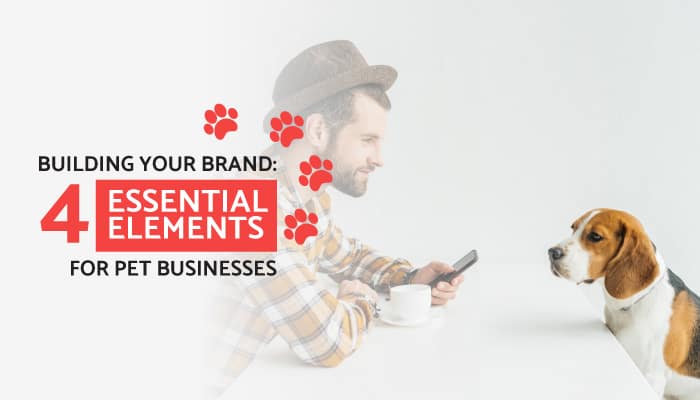By Casey Dorman
It’s an exciting time to be part of the pet care industry. With furry friends being treated more and more like family members, pet-focused goods and services of all kinds are seeing a rise in sales.
According to the American Pet Products Association, consumers spent $95.7 billion on their pets in 2019, with an expected increase to $99 billion in 2020. Clearly, there’s a massive market for appealing to doting pet parents.
To be successful in this rapidly growing industry, pet care professionals must brand themselves as unique, trustworthy, and quality service providers.
Whether you’re revamping an established business or entering the pet care industry for the first time, a compelling brand image is crucial to attracting new clients and increasing customer loyalty.
Don’t worry—we’re here to help. At Gingr, we provide pet businesses with the tech tools they need to operate efficiently and create relationships with satisfied customers3. Pet care providers across the country rely on our software as a cornerstone of their branding and client communication strategy. To help you develop a powerful brand of your own, we’ve created a list of a few key elements to consider:
- Define and communicate your speciality.
- Use pricing to position your brand in the marketplace.
- Invest in your community reputation.
- Provide a positive customer experience.
A strong, recognizable brand will help your business thrive as the pet care industry continues to grow in 2021. Let’s dive in.
Define and communicate your speciality
 With any business, one of the most important things to start out with is understanding your position in the marketplace. What competitive advantage will set you apart from other similar providers?
With any business, one of the most important things to start out with is understanding your position in the marketplace. What competitive advantage will set you apart from other similar providers?
For instance, you may choose to:
- Target a unique segment of consumers
- Align your business with a set of core values
- Offer services that other providers don’t
- Create a specific voice and tone for your brand, like youthful or refined
To consider this more closely, imagine the scenario of opening a dog grooming business. Are you trying to cater to a more luxury market or serve the average pet owner? Will you offer mobile grooming services? Will you specialize in certain breeds or coat styles?
These are just a few of the characteristics that could help a dog grooming business stand out, and each area of the pet industry will have its own qualities to consider.
Once you’ve honed in on the elements that differentiate your business, you’ll be able to use these features and values to shape your brand. As you market your services, be sure to highlight what makes your business stand out. Competitive advantage doesn’t mean much if you aren’t communicating it effectively to potential customers.
Use pricing to position your brand in the marketplace
You know that pricing is a core component of your business plan, but have you considered how important it is to your overall brand?
When setting a price for your services, you should not only factor in the necessary elements of the profit equation but also consider what that pricing tells to customers.
Carefully consider the message your pricing delivers so you can avoid the following scenarios:
- Too low. If your price is set unusually low, that may signal to customers that your services aren’t as valuable. Potential clients need to be able to trust you with a beloved member of their families. If they see steep discounts, they may worry you’re cutting corners to keep costs low.
- Too high. If you’re going to charge a premium price for your services, be sure you clearly articulate why. Benefits like a higher staff-to-dog ratio or a state of the art facility can justify a heftier price tag as long as you can explain them.
- Too complex. Potential customers need to be able to easily understand your pricing structure. If you have a complicated system that combines an hourly or daily rate with a list of specific fees, it may be wise to simplify.
A price that aligns with the rest of your business’s brand and fits into the competitive landscape will be most effective. Most likely, you’ll want to aim for a middle-of-the-road “Goldilocks” price or a higher price that is clear in both why and how it is set.
Invest in your community reputation
 Once your brand is well-defined, it’s time to start sharing it with the world. By investing in your local reputation, you’ll be able to attract new clients and bolster your status as a trustworthy member of your community.
Once your brand is well-defined, it’s time to start sharing it with the world. By investing in your local reputation, you’ll be able to attract new clients and bolster your status as a trustworthy member of your community.
Consider the following ways to bolster your reputation online and in-person:
- Online reviews. If you’re an established business already, make a push for loyal customers to leave reviews on popular platforms like Yelp and Google.
- Local SEO. Search engine optimization is important to ensuring customers can find your business online. Make sure your brand is represented well on Google My Business so it can appear appropriately in local results.
- Corporate philanthropy. Consider incorporating charitable elements into your business plan. Initiatives like a matching gift program, sponsorships, or in-kind donations to local nonprofits signal that you care about your community and could bring on some positive press.
These strategies will help you to cultivate brand awareness and position your business as a reputable and qualified service provider. Just be sure to build these in a natural and honest way—offering customers free services in exchange for glowing reviews is a shady move that could do more harm than good.
Provide a positive customer experience
Compelling marketing materials and great online reviews should help get new clients in the door, but another core brand consideration is how to ensure those clients return again and again.
By focusing your efforts on a positive customer experience, you will improve client retention and encourage those happy customers to share your business with others.
Consider the following characteristics of your customer experience:
- Convenient. Offerings like online bookings and a customer portal ensure that your clients can interact with your business in a way that works for them.
- Efficient. Customers should be able to complete essential tasks (like dropping off pets or submitting vaccination records) quickly and easily.
- Contactless. In the COVID-19 era, you need to keep customers and staff safe by minimizing face-to-face interactions as much as possible. It’s recommended to implement contactless drop-off and check-out procedures and offer touch-free payment options.
Pet business software can help you provide these benefits to your customers in ways that just aren’t feasible with analogue tools. Features like integrated payment processing, communication tools, and a customizable client portable can help your business offer the most convenient experience possible.
All in all, a well-defined brand and a positive reputation will help your pet business to thrive. As you prepare to launch or re-brand your dog daycare, kennel, or grooming business, consider how to differentiate your brand and share it with the world. With these strategies, you’ll be well on your way to building a brand worth wagging about. Best of luck!
Text faces are small strings of characters that can describe emotions and make your text stand out. Browse them in the gallery.
Casey is the Sales Manager at Gingr software. Originally from Indianapolis, he now lives in Colorado with his wife and dog, Dexter. Their hobbies include hiking, skiing, and visiting local breweries.
